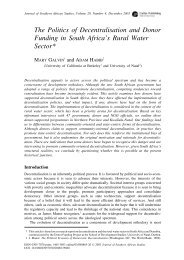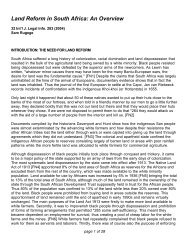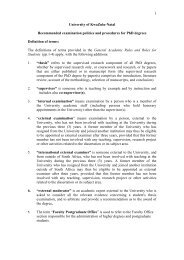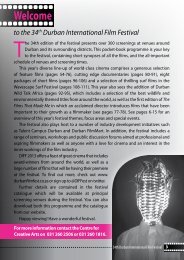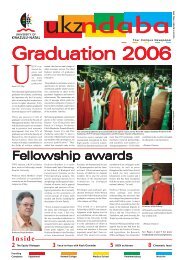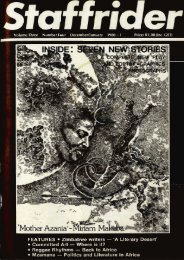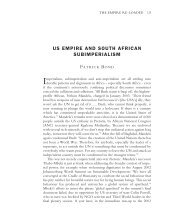Staffrider Vol.6 No.2 1985 - DISA
Staffrider Vol.6 No.2 1985 - DISA
Staffrider Vol.6 No.2 1985 - DISA
Create successful ePaper yourself
Turn your PDF publications into a flip-book with our unique Google optimized e-Paper software.
TALKING STORYA <strong>Staffrider</strong> feature in which writers andcritics discuss storytellers and their work.In this issue MIKE KIRKWOOD writes aboutIsaac Babel's 'The Life and Adventures ofMatthew Pavlichenko'.'You are my old master, you have had the command longenough, now I am your master' — said the slave Maurits vanMauritius to Cornelis Coetze one day in the year 1800, ona lonely farm in the Roggeveld, moments before he beat hisold master's brains out with a crowbar. No doubt words andblows to the same effect had been meted out before. Nodoubt they would be again. Nor have we outlived the dreamof the rising and the retribution. Sometimes it seems toparalyse us, culturally speaking. Obsessively contemplatingthe moment of apocalypse, the dawn of liberation and thenew society, few of our writers have been able to create thescene between Maurits and Cornelis — in all its variations —with any conviction. Perhaps Babel's version of Nemesis, setin the Russian revolutionary period, has something to teachus.Its author had, of course, one great advantage. Born inOdessa in 1896, Isaac Babel had lived through the Russianrevolution — Matthew Pavlichenko's 'little year Eighteen, mysweetheart' — when he came to write this story. Afterwards,he joined Budyonny's Cossack cavalry for the Polishcampaign of 1920. The ani-Semitism of the Cossacks (Babelwas Jewish, and so were many of the Polish civilians in thecommunities ravaged by the war) and their reckless, pulsatilephysicality (Babel was slightly built, wore glasses, and didn'tride well) made his decision to enlist with them remarkable.A number of the resulting stories (published in English asCollected Stories in the Penguin Modern Classics) turn on themixed feelings the Cossacks have about him, and on his needto find some measure of acceptance among them if he isgoing to get to grips with his subject. (One thinks ofMtutuzeli Matshoba among the migrant workers, of NjabuloNdebele or Mbulelo Mzamane and the street gangs that figurein their stories of childhood.)In deliberately seeking out experience which can beshared, and actively identifying himself with his 'material'in order to allow it to speak and tell, Babel was choosing togo down the old road of that 'timeless tradition of storytelling'mentioned by Njabulo Ndebele when he introducedthe Turkish 'teller', Yashar Kemal, in our last issue. (Washe also choosing the 'road' of the story rather than the 'map'of the novel, a mode of fiction which establishes a qualitativelydifferent connection with experience?) Other attributes ofthe storyteller stand out in him too — more than this briefarticle can hope to itemize — but this one may merit specialnotice because it touches on a theme implicit in the <strong>Staffrider</strong>literary project from the beginning: the nature of'committed' writing. I believe that the more one considersthe possibility of storytelling in the contemporary world (the'global' as opposed to the 'organic' village, perhaps) the moreone is driven to conclude that it is the method which declaresthe committed writer rather than the subject addressed. It ishow we allow a subject to speak rather than what we make itsay that ensures its accessibility to a participant rather than areflective readership.The Long and the Short of ItAs with oral storytellers, so with the writers there are thosewho like to spin it out (another great Russian, Leskov, islike this) and those who like to cut it to the bone. Babel isdefinitely in the latter category. In this story it is not onlythe life of Pavlichenko which is anatomized in deft, seeminglycareless strokes: the ancient and modern history of ruralRussia are compacted into his few pages, together withthe political economy of the landowner's estate. Babel's-striking ability to select the most telling 'moments' in hisstory is part of this. So is the sharply focused, emblematicway in which he depicts the physical world — from the wildenergy of the horses working out 'at the far end of the fields',beloved of the peasants, to the scarlet saddle cloths 'brighterthan the Tsar's flags' on which the master 'strutted about'.Both of these skills in the writer draw on oral storytelling.The shifts in the story happen quite naturally within thenarrative style which Pavlichenko uses — a style which, oneimagines, Babel had often encountered among the Cossackshe campaigned with. This talent for laconic compression, forleaving out what it is not necessary to say, is imbedded inpeasant speech. ' "Nastasya," I says; "or maybe you^rekidding me." ' This is the style of love declarations downStavropol way.Similarly, in creating an emblematic physical worldBabel stays within the limited field of vision of his storyteller,but explores the resources of peasant experience andspoken idiom to bring out the full significance of ordinarythings. Thus Pavlichenko describes himself as being 'soakedin milk and stinking of it like a sliced udder' and then tellsNastasya that his heart is 'just milky, I dare say. It's terriblehow I smell of milk.'Pavlichenko the StorytellerIn some of his stories — like this one — Babel creates a storytellerfigure within the tale. More than this, he creates acommunity of readers-, people who, like the village audiencein the oral tradition, have something to gain from theirparticipation in the storytelling. They gain in entertainment,certainly; also by way of what Walter Benjamin 1 calls'counsel' — the kind of wisdom that can be put to use inone's own life. About counsel Benjamin remarks that 'it isless an answer to a question than a proposal concerning thecontinuation of a story which is just unfolding. To seek thiscounsel one would first have to be able to tell the story.(Quite apart from the fact that a man is receptive to counselonly to the extent that he allows his situation to speak.)'Compare this with Ndebele's formulation in our last issue:' . . . the reader's emotional involvement in a well-told storytriggers off an imaginative participation in which the readerrecreates the story in his own mind, and is thus led to drawconclusions about the meaning of the story from theengaging logic of events as they are acted out in the story.'The first community of readers suggested by the story isthat of the Cossack revolutionary soldiers immediatelyaddressed by Pavlichenko, a community of which Babel hadfirst-hand experience and which, as we have seen, played avital role in the generation of his work. A further, or underlyingcommunity is glimpsed in the narrator's references to'our Stavropol district' from which this Cossack generalcomes. It is also worth noting that the storyteller is firstidentified as someone from both these communities who isfamiliar with the story of Pavlichenko's life. It is only at thebeginning of the second paragraph, in one of those surprisestrokes through which the story is impelled forward (and thereader/listener's pleasure considerably enhanced) that wediscover Pavlichenko himself to be the narrator.STAFFRIDER, VOL. 6 NO. 2, <strong>1985</strong> 11




